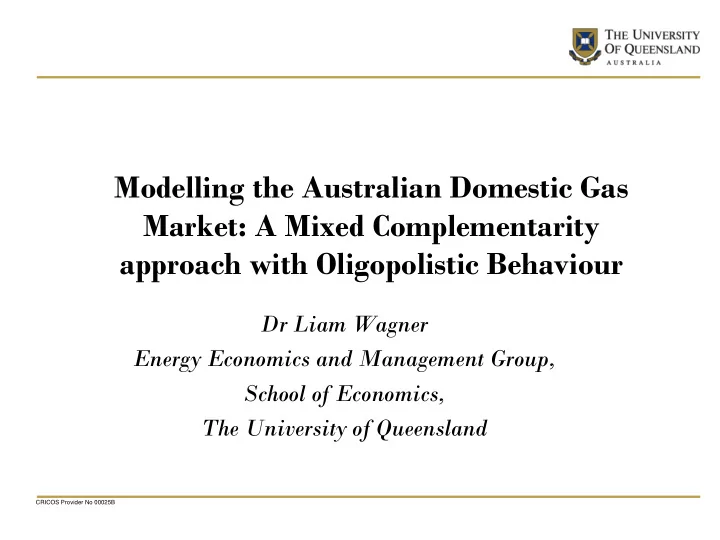

Modelling the Australian Domestic Gas Market: A Mixed Complementarity approach with Oligopolistic Behaviour Dr Liam Wagner Energy Economics and Management Group, School of Economics, The University of Queensland CRICOS Provider No 00025B
Introduction • Introduction • Australia’s Gas. • Ateshgah: An Australian Domestic Gas Model • Initial Modelling • Further Work CRICOS Provider No 00025B
Australia’s Gas Resources CRICOS Provider No 00025B
Gas Developers CRICOS Provider No 00025B
Proponents • APLNG – Origin (Australian) 37.5% – ConocoPhillips 37.5% – Sinopec 25% • QCLNG – British Gas 100% – Formerly Queensland Gas Corporation • GLNG – Santos 30% – PETRONAS 27.5% – Total 27.5% – KOGAS 15% • ALNG (FID still open/Delayed) – Arrow Energy Australia: Former owner now a JV between – Shell 50% – Petro China 50% CRICOS Provider No 00025B
CRICOS Provider No 00025B
Ateshgah: An Australian Gas Model • The domestic gas model is a multi-period dynamic Spatial equilibrium model of the Easter Australian Gas Market. • Represents Oligopolistic Competition to more adequately represent agent behaviour. • Developed in GAMS to take advantage of the Mixed Complementarity Programming (MCP) framework. • Problem is derived from the classic Non-Linear Program (NLP) as there main participant problems. CRICOS Provider No 00025B
Mixed Complementarity Programs • Developed in the 70’s and 80’s • Well suited to commodity market problems • An early no-energy application was applied to agricultural markets such as Dairy (A Spatial Equilibrium Model for Imperfectly Competitive Milk Markets Competitive Markets, American J Ag Econ 1997) • Nash-Cournot Oligopolistic market structure has been examined for Gas (European Gas Model, GASTEL) • Coal Markets (The Cournot competition in the spatial equilibrium model, Energy Economics 2002) CRICOS Provider No 00025B
Classical Spatial Equilibrium Problem • Producers Problem: – Produce gas across a portfolio of nodes in a network to maximize producer surplus – Minimize transport costs to ship gas to demand side – Marginal cost function is a non-linear (monotonically) increasing equation. • Demand Side Problem: – Serve demand, while purchasing the least cost gas to maximize consumer surplus. – Minimize transport costs – Demand function is represented as an inverse (Non-)Linear equation (convex) CRICOS Provider No 00025B
• Transportation Owner and Market Clearance Equations: – Ensure pipeline flow is maintained to service supply and demand agents – Clear inflows and outflows for each node CRICOS Provider No 00025B
• Its coverage extends to: – 61 node network – 13 Basins – 111 producing areas – >100 pipeline flows – 3 Main Demand Side Sectors • LNG Exporters • Electricity Generation • Mass Market/Light Industry – 51 Agents (aggregated by type at each node) CRICOS Provider No 00025B
Model Characteristics • Also this model has is able to describe the following physical/operational characteristics: – Pipeline flows • Both bi-directional and some uni-directional connections • Differential tariffs for each direction • Max/Min-flow constraints – Production • Min and Max production constraints • Inter-temporal constraints (Maximum production in line with Ultimately Recoverable Reserves) • Cost of production based on non-linear Golombek Price Curve CRICOS Provider No 00025B
Golombek Marginal Cost Function • There are a number of choices for the form of this cost function depending on where the gas is being extracted (onshore or offshore) as well as the type of gas (conventional or unconventional). • In general though, this function should be increasing in its argument (producing more gas costs more money). • Internationally a non-linear production cost curve has been introduced by: – Rice World Gas Model – GASTEL CRICOS Provider No 00025B
• alpha, beta and gamma are constants fitted to tranches of the expected costs of extracting increasing more expensive gas reserves • Volume: that a producer chooses to produce in a given year • Capacity: is the available gas that a producer can extract given previous years extraction, capacity = (URR – production in previous years)/(expected life of the reserve) CRICOS Provider No 00025B
CRICOS Provider No 00025B
Golombek Marginal Supply Curve CRICOS Provider No 00025B
CRICOS Provider No 00025B
Model Characteristics • Demand Side – Min and Max demand for each node • Currently aggregates all sectors and agents at the node from exogenous data – Reference, Min and Max price – Aggregated Elasticity for demand at the node – Data on demand and elasticity's sourced from: • Gas Powered Generation Demand: Australian Energy Market Operator • Industrial Demand: BREE (Australian Government) • Residential Demand: AEMO and Core Energy • LNG Exports: AEMO, Core, BREE, ABARES etc CRICOS Provider No 00025B
Modelling • The market conditions for LNG are evolving rapidly in Australia and globally • Initially we consider 2 main scenarios here • Scenario 1: Base Case – Entry timing as expected for APLNG, GLNG, QCLNG, Arrow supply made available to current proponents – International prices derived from forecasts of the Japanese Crude Cocktail (EIA Reference Oil Prices, World Energy Outlook 2013) – Reference Gas Prices Net-back from cif-Japanese Hub to fob- Gladstone equivalent price • Scenario 2: Arrow gas delayed/unavailable until 2020 – Entry timing as expected for APLNG, GLNG, QCLNG – Arrow gas fields ramped down/off CRICOS Provider No 00025B
Scenario 1: Base Case CRICOS Provider No 00025B
Scenario 2: Arrow Delayed CRICOS Provider No 00025B
CRICOS Provider No 00025B
Further Development • Multi-Agent Model – Field productivity – Sectorial Demand changes due to shifts in price – Manufacturing/industrial users by node – Disaggregation of all fields (by node) – Producer Portfolio behaviour – Electricity Generator Put Option for contracted gas • i.e. Swanbank E near Ipswich • Application of the modelling platform to other commodities – Coal – Oil • Further integration with electricity market modelling platforms (such as Plexos) CRICOS Provider No 00025B
Recommend
More recommend